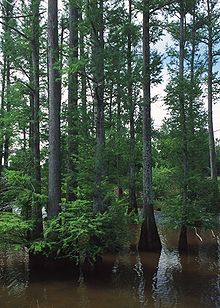
Back طقسوديم Arabic طقسود (كائن) ARZ Taksodium Azerbaijani Taxodium Catalan Taxodium CEB Tisovec (rostlina) Czech Sumpcypres Danish Sumpfzypressen German Bagnowa cypresa DSB Taksodio Esperanto
| Taxodium Temporal range:
| |
|---|---|

| |
| Bald cypress forest in a central Mississippi lake | |
| Scientific classification | |
| Kingdom: | Plantae |
| Clade: | Tracheophytes |
| Clade: | Gymnospermae |
| Division: | Pinophyta |
| Class: | Pinopsida |
| Order: | Cupressales |
| Family: | Cupressaceae |
| Subfamily: | Taxodioideae |
| Genus: | Taxodium Rich. |
| Type species | |
| Taxodium distichum (L.) Rich.
| |
| Species | |
| Synonyms | |
| |
Taxodium /tækˈsoʊdiəm/[1] is a genus of one to three species (depending on taxonomic opinion) of extremely flood-tolerant conifers in the cypress family, Cupressaceae. The name is derived from the Latin word taxus, meaning "yew", and the Greek word εἶδος (eidos), meaning "similar to."[2] Within the family, Taxodium is most closely related to Chinese swamp cypress (Glyptostrobus pensilis) and sugi (Cryptomeria japonica).
Species of Taxodium occur in the southern part of the North American continent and are deciduous in the north and semi-evergreen to evergreen in the south. They are large trees, reaching 100–150 ft (30–46 m) tall and 6.5–10 ft (2–3 m) (exceptionally 36 ft or 11 m) trunk diameter. The needle-like leaves, 0.2–0.8 in (0.5–2 cm) long, are borne spirally on the shoots, twisted at the base so as to appear in two flat rows on either side of the shoot. The cones are globose, 0.8–1.4 in (2–3.5 cm) diameter, with 10–25 scales, each scale with one or two seeds; they are mature in 7–9 months after pollination, when they disintegrate to release the seeds. The male (pollen) cones are produced in pendulous racemes, and shed their pollen in early spring. Taxodium species grow cypress knees, when growing in or beside water. The function of these knees is currently a subject of ongoing research.
- ^ Sunset Western Garden Book, 1995:606–607
- ^ Everett, Thomas H. (1982). The New York Botanical Garden Illustrated Encyclopedia of Horticulture. Vol. 10. Taylor & Francis. p. 3299. ISBN 978-0-8240-7240-7.